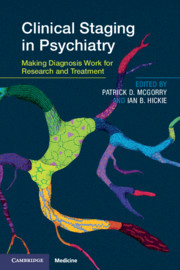Book contents
- Clinical Staging in Psychiatry
- Clinical Staging in Psychiatry
- Copyright page
- Contents
- Contributors
- Foreword
- Acknowledgements
- Section 1 Conceptual and Strategic Issues
- Section 2 Progress with Clinical Staging
- Chapter 5 The Utility of Clinical Staging in Youth Mental Health Settings
- Chapter 6 Neuroimaging and Staging
- Chapter 7 Staging of Cognition in Psychiatric Illness
- Chapter 8 Neuroinflammation and Staging
- Chapter 9 Bioactive and Inflammatory Markers in Emerging Psychotic Disorders
- Chapter 10 Electroencephalography and Staging
- Section 3 Novel Treatment Strategies
- Section 4 Novel Treatment Strategies
- Index
- Plate Section (PDF Only)
- References
Chapter 9 - Bioactive and Inflammatory Markers in Emerging Psychotic Disorders
from Section 2 - Progress with Clinical Staging
Published online by Cambridge University Press: 08 August 2019
- Clinical Staging in Psychiatry
- Clinical Staging in Psychiatry
- Copyright page
- Contents
- Contributors
- Foreword
- Acknowledgements
- Section 1 Conceptual and Strategic Issues
- Section 2 Progress with Clinical Staging
- Chapter 5 The Utility of Clinical Staging in Youth Mental Health Settings
- Chapter 6 Neuroimaging and Staging
- Chapter 7 Staging of Cognition in Psychiatric Illness
- Chapter 8 Neuroinflammation and Staging
- Chapter 9 Bioactive and Inflammatory Markers in Emerging Psychotic Disorders
- Chapter 10 Electroencephalography and Staging
- Section 3 Novel Treatment Strategies
- Section 4 Novel Treatment Strategies
- Index
- Plate Section (PDF Only)
- References
Summary
Despite over a century of intensive research, no single biological marker has successfully translated into daily clinical practice. A key challenge in psychiatric research is that traditional diagnostic categories represent phenomenological constructs that do not necessarily circumscribe a biological homogenous entity, but encompass a whole range of disorders presenting with similar phenotypes. The clinical staging model shifts our focus to search for markers relevant to particular stages of mental disorders and provides a useful framework to differentiate overlapping and heterogeneous syndromes. The identification of such “stage” dependant markers may be more meaningful and of greater prognostic and therapeutic value than our quest for categorical disease markers. In this chapter, bioactive and inflammatory markers in emerging psychotic disorders are discussed. Their specific role in brain development, psychiatric disorder onset and management are reviewed. Implications for future research are also provided.
- Type
- Chapter
- Information
- Clinical Staging in PsychiatryMaking Diagnosis Work for Research and Treatment, pp. 191 - 203Publisher: Cambridge University PressPrint publication year: 2019



